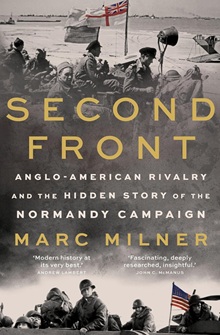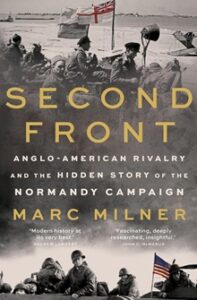The subtitle of this book is ‘Anglo American Rivalry and the hidden story of the Normandy Campaign’ and the theme is American political and military machinations to ensure that Allied strategy in the Second World War was diverted to the support of American interests to the detriment of British ones. Milner is not the first to explore this view, which was looked at by the late Professor John Charmley in his Churchill, the End of Glory in which Churchill is depicted as having been constantly outwitted by Roosevelt and Stalin, but Milner is particularly interested in the run up to Operation Overlord, the landings in Normandy on 6 June 1944, its inception and consequences, which culminated in a US dominated western world and the demise of the British Empire, which latter the author sees as an American aim all along.
The first part of the book traces developments between the wars and shows how the American myth that they alone won the First World War was created – a myth recently repeated by President Trump, even if he failed to realise the Japan was an ally in that war. The effects of the great depression are well covered, including how the immediate imposition by the US of tariffs made the situation worse, something still relevant today, as is the effects of the USA’s failure to join the League of Nations and retreat into isolationism. Contrary to some opinion Millner shows that it was the Americans who favoured Torch, the Anglo American landings in North Africa, in order to give American troops some battle experience, although in the US media it was portrayed as very much an American operation. The information war is well covered and shows that US military decisions were often, perhaps mainly, linked to the politics of the American electoral cycle. Unlike in the UK where on the outbreak of war a coalition government was formed and there was no election between 1935 and 1945, in the US elections were held every two years, presidential every four years and for the Congress in between, and Eisenhower was under much pressure from Roosevelt to launch Torch in time for the 1942 mid-term congressional elections on 3 November (he was unable to and the landings took place on 8 November).
British officers organising the public relations campaign were faced with the realisation that the American public were uninterested in the war in Europe, and along with most members of Congress, would have preferred an all-out offensive in the Pacific. Merchant ships being built in the US for the British (and paid for by them) were often arbitrarily sequestered by the US navy for the Pacific campaign, and during the discussions that led to Lend Lease American politicians often pointed to the British defection of war debt in 1934. That the money owed to Britain but which debtors either could not or would not repay pretty much equalled the amount owed by the UK to the USA was ignored. Britain was forced to liquidate all her commercial holdings in the USA for sums far below their value and to surrender her holdings of gold elsewhere. (the UK made her final payment of First World War debt to the USA in 2014, and that for World war Two – largely lend lease – in 2006). The book shows that unstated American policy before and during the war was to replace British global influence with American, and particularly to corner her markets and replace sterling as the currency of international trade. British politicians only began to realise when it was too late that when the US declared its wish to eradicate Fascism it also wished to eradicate imperialism, and this included the British Empire. The US particularly opposed British rule in India and conspired with those indigenous elements that wished to replace it. It is perhaps going too far to blame the US diversion of British merchants ships to its Pacific war on the Bengal famine, but it would have been a factor. Milner shows that any operation including American troops was portrayed by US public relations and media as being solely American, despite the troops and assets in the Mediterranean and Italy being overwhelmingly British, with the fact that a very large portion of Mark Clark’s Fifth US Army was actually British being ignored. Again the US public were kept blissfully unaware that the majority of the troops, ships and aircraft involved in Overlord would be British, and the Burma war was rarely mentioned and then only in the context of Chiang Kai Check’s Chinese.
The minor, but no less important, operations to pave the way for Overlord are covered in detail: the Transportation Plan, to destroy the French and Belgian railway network; the clearing of German mines and torpedo boat squadrons from the Channel and Operation Fortitude the deception plan to make the Germans conclude that the landing, when it came, would be in the Pas de Calais. The landings and subsequent fighting in North West Europe are covered in detail. While the attempt by a Canadian brigade to capture Carpiquet airport on D+1 was more of a shambles than is admitted, the aims and achievements of Operation Goodwood is given a lot more credit than has been the verdict of many historians.
The overriding thrust of this part of the book is that the Americans were aiming to win the war as quickly as possible, while British concerns included the shape of Europe after the war, their suspicions of Soviet motives not being shared by Roosevelt. It became clear that America saw the post war world as an American Soviet condominium, and not one of Anglo American cooperation. The discussions leading to the Bretton Woods agreement, which ended Britain’s role as the financial centre of the world are examined, as is the American conclusion that neither the Dutch nor the British should be allowed to reclaim their Asian colonies.
For those of who have had – perhaps naively – a belief in the ‘special relationship’ this book is sad, but essential reading, and is particularly relevant today, when while the US under Donald Trump is not yet an enemy, she is certainly not a friend. This book is a magisterial analysis of nearly 800 pages including extensive and detailed notes and a comprehensive biography. As a Canadian the author can be excused for occasionally overselling the Canadian case, but there is much truth in his assertation that Canada’s economic and military contribution to the British and Allied efforts in the Second World War has not received the recognition that it deserves.
A fascinating treatise strongly recommended.
Second Front: Anglo-American Rivalry and the Hidden Story of the Normandy Campaign by Marc Milner is published by Yale University Press. Gordon Corrigan is a historian and the author of The Second World War: A Military History.







